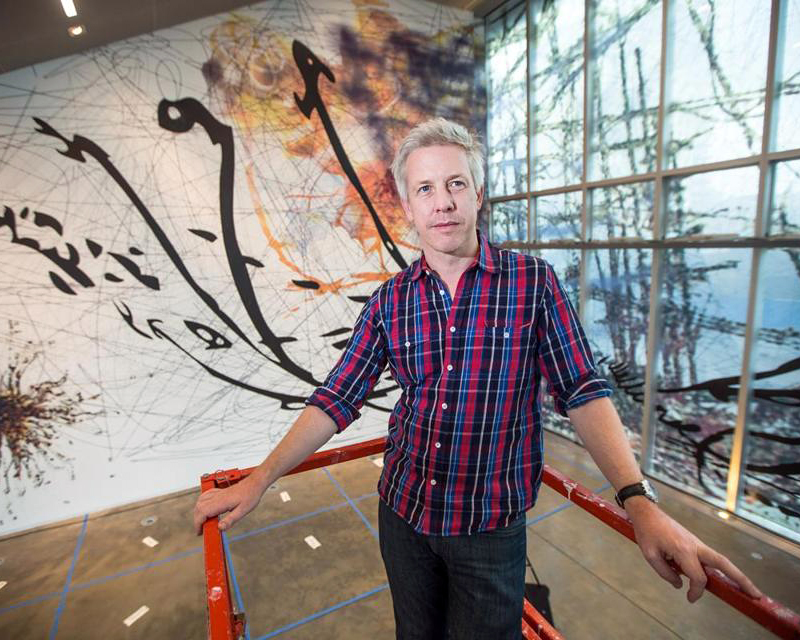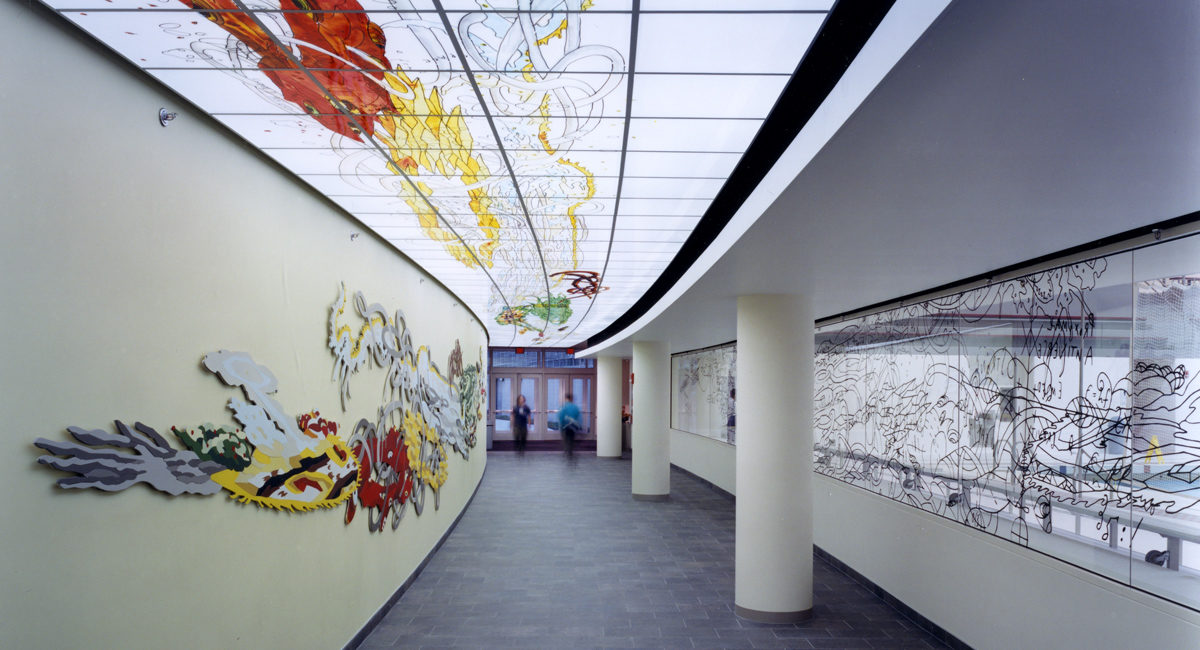Matthew Ritchie researches technology’s growing scope as CAST visiting artist.
Matthew Ritchie is no stranger to the MIT campus. The contemporary artist, who works in installation, performance, painting, drawing, sculpture and sound, created a site-specific installation at the Zesiger Center in 2002 and later collaborated on a multimedia performance piece with MIT students and composer Evan Ziporyn, Kenan Sahin Distinguished Professor of Music and Faculty Director of the Center for Art, Science & Technology (CAST). The two have collaborated on numerous other projects, including The Morning Line as part of the 3rd Seville International Contemporary Arts Biennale, Monstrance/Remonstrance at ICA Boston and, more recently, The Demon In the Diagram, at the Moody Center for the Arts in Houston.
As the 2018-19 Dasha Zhukova Distinguished Visiting Artist at CAST, Ritchie returns to engage with the MIT community and explore the implications of technology’s ever-expanding role in our culture and its relationship to art.
These inquiries, literally the size of the universe, are both daunting and exciting, says Ritchie, informed by an expansive technological toolkit.
CAST: Have you noticed any changes in the culture at MIT since you’ve been visiting the campus?
RITCHIE: It seems like it’s become a lot more intense recently, as we’ve all become a lot more reliant on technology. It used to feel like more of a strange laboratory. Now it feels more organized and oriented towards very specific, large, cultural questions that we can’t avoid, due to do the computational and technological substrates that our whole society runs on.
CAST: That’s interesting. It’s also a very unique campus physically.
RITCHIE: I’m always struck here by the connective tissue of MIT, the sort of corridors upon corridors, that kind of sprawling linkages, which is very distinct from other campuses, where you mostly go from building to building in dedicated siloes. Here, in a kind of strange way, you have these sort of tubes, or connecting circuits. That space could be addressed in a really interesting way.
CAST: What has been the focus of recent conversations on campus?
RITCHIE: A common theme that I’m encountering, possibly because I’m an artist, is the question of how do we resist the apparently totalizing logic of a technologically-driven society. Technology doesn’t really have an inherent logic, but it’s easy to fall under the spell of, well, we just need to do more of it, without thinking about either the long term goals or the process itself, the entelechy of making.
As an artist, that’s of great interest to me. What kind of picture can you make of a moment in time when a society fully embraces its technological identity and is embodied somewhere like MIT? How can new technologies of picture-making expand the limits of what we can imagine next? What is emerging and what remains hidden?
CAST: I would imagine that artificial intelligence has come up in your discussions.
RITCHIE: One of the things in the back of everyone’s minds is if we’ve already reached the moment where a non-human intelligence can be created – and hopefully in some sense collaborated with. I mean, this is one of the great dreams of technology, a Galatea. What was once a myth, like flight, is slowly becoming a reality. Personally, I don’t think of it as the kind of threat we see in the movies – some rogue super intelligence that’s going to take over human creativity. The more likely danger seems to be the slow erosion of expectations through an evolving technology that leads you to a kind of averaging out. Many mathematical models are essentially about getting a large group of entities to a kind of a B plus—an average solution that’s best for most people. To the AI, it might be the optimal result, but it produces the kind of utilitarianism that we all dislike in reality. Instead of Icarus, you get United Airlines – instead of an oracle, you get Siri. And yet we’re submitting to it. So it is a math problem – but it’s also an aesthetic problem – or more fully, a problem of aisthesis – how an aesthetic regime can define, expands, or limits our physical and intellectual scope of enquiry.
As an artist, I have the luxury and the freedom to be able to say, well, what about this problem? Even though we will use AI to build large scale and very average systems, can we also collaborate with it to envisage more exceptional informational environments? That’s what is most interesting about the conversations I’ve been having with engineers, scientists and researchers at MIT. But I don’t want to misrepresent this dynamic. I think it’s gone past the easy phase of say the 1920s, where the artists could be the exception to the rule, “the ones who aren’t like that.” The momentum has really shifted in the last couple of decades to a vastly more organized, cyberneticized, connected, engineered society of exactly the kind that was predicted, certainly for over hundred years – although we we can find examples in literature from even earlier. But I can at least propose questions in conversation.
CAST: That seems to make your residency that much more relevant.
RITCHIE: I think any artist coming in would feel the same, it’s thrilling be a permitted exception to the systemic solution. MIT has a whole initiative called MIT Solve, all these different branches that solve problems. I thought that was really interesting when I first heard about it, that they called the whole thing “solve” and focused on this idea of solution. A really deep problem in utilitarian philosophy is what even constitutes ‘the solution’. Artists are the flip side of that. It’s all bespoke – no-one ever thinks of art as ‘the solution’. But the ability of art to reframe large questions from different perspectives is one of its great historical contributions. So I think somewhere between those two things is what’s interesting for me, particularly about this time in history.
This is a truly special, radical moment, like the Renaissance. Lots of amazing things came out of the Renaissance. And lots of terrible things came out of it. I don’t think it’s useful to try and insist that the Renaissance was the solution to the medieval period, which is the danger as you start to think of social technologies as uniformly improving. That kind of rhetoric ended up creating some of the worst things that people have ever done. But at the same time, it’s like the Renaissance! So we should all enjoy being part of a unique moment of human transformation together, and kind of go for its most difficult problems. But be really explicit about the contradictions, rather than accepting or assuming they’re sort of baked into the calculus.
CAST: What is your vision for this residency?
RITCHIE: I’m trying to hold open the answer to that as long as possible. It will be great to revisit this initial stage in two years and see if we got anywhere by asking these really difficult interlinking questions at the start and whether that manifests into something really unexpected. To do that without expectation, unattached to any physical outcome, is a great privilege. Inevitably, there’ll come a moment where we start to focus on, well, what can we make of all this, because I’m an artist and artists make things. It seems important, especially at this moment, to defer the idea of any single solution and I suspect any project will reflect that.



